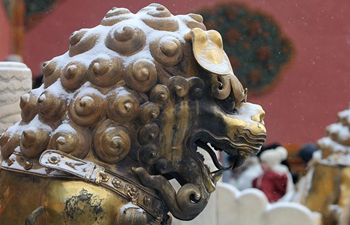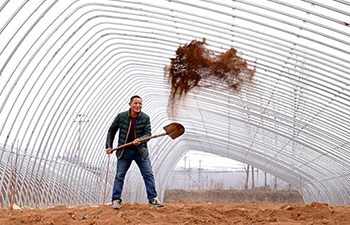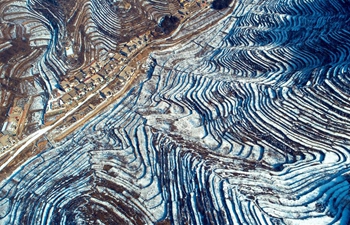LOS ANGELES, Feb. 19 (Xinhua) -- U.S. researchers have created an extremely light and highly durable ceramic aerogel which can withstand intense heat and severe temperature changes and be used for insulation on space missions.
In an interview with Xinhua on Tuesday, Duan Xiangfeng, professor of chemistry and biochemistry at the University of California, Los Angeles (UCLA) and lead of the research team, said the new aerogel is much more durable after exposure to extreme heat and repeated temperature spikes, and much lighter. Its unique atomic composition and microscopic structure also make it unusually elastic.
The new material is made of thin layers of boron nitride, a ceramic, with atoms that are connected in hexagon patterns, like chicken wire.
"The key to the durability of our new ceramic aerogel is its unique architecture," Duan said. "Its innate flexibility helps it take the pounding from extreme heat and temperature shocks that would cause other ceramic aerogels to fail."
The new aerogel was invented by UCLA researchers and collaborators at eight other research institutions including three from China, namely, Harbin Institute of Technology, Hunan University and Lanzhou University.
Ceramic aerogels have been used to insulate industrial equipment since the 1990s, and they have been used to insulate scientific equipment on the National Aeronautics and Space Administration's (NASA) Mars rover missions.
Duan told Xinhua that Mars temperature averages minus 53 degrees Celsius with variation from minus 128 degrees Celsius during polar nights to 27 degrees Celsius on the equator during midday at the closest point in orbit to the Sun.
"The extreme thermal environment on Mars asks for an effective thermal insulation to keep equipment within allowable temperature limits and to limit power consumption," he said.
The primary hardware that requires protection from the thermal environment are the electronics, batteries and temperature-sensitive components of the telecommunication systems, he said.
Duan said the primary batteries are the most sensitive of the components. Above 40 degrees Celsius they will autodischarge, and below 40 degrees Celsius they will not provide a current.
However, other electronics can withstand a wider temperature range, but minimizing temperature swings improves reliability, he said.
"The current silica aerogel is good, but typically brittle, without insufficient mechanical or thermal stability, and may easily fracture under repeated thermal shocks," he said.
The new ceramic aerogel is highly flexible, with excellent mechanical and thermal stability, has a very low density and extremely low thermal conductivity, and could offer unique opportunities for thermal insulation in space, Duan said.
The new material can be compressed to 5 percent of its original volume and fully recover, while other existing aerogels can be compressed to only about 20 percent and then fully recover.
The research was published in Science last week.

















